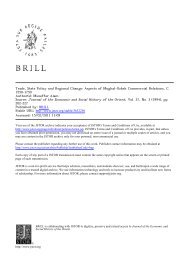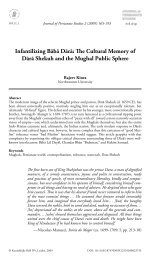The Mughals, the Sufi Shaikhs and the Formation of the Akbari ...
The Mughals, the Sufi Shaikhs and the Formation of the Akbari ...
The Mughals, the Sufi Shaikhs and the Formation of the Akbari ...
Create successful ePaper yourself
Turn your PDF publications into a flip-book with our unique Google optimized e-Paper software.
FORMATION OF THE AKBARI DISPENSATION 143<br />
Naqshb<strong>and</strong>i <strong>Shaikhs</strong> <strong>and</strong> Timurids in Mawarannahr<br />
In <strong>the</strong> late-fourteenth century, <strong>the</strong> <strong>Mughals</strong>’ great ancestor Amir<br />
Timur himself is reported to have maintained close relations with<br />
Amir Kulal, <strong>the</strong> pir <strong>and</strong> preceptor <strong>of</strong> Shaikh Baha al-Din Naqshb<strong>and</strong>,<br />
after whom <strong>the</strong> <strong>Sufi</strong> silsila came to be known subsequently. 16 This was<br />
principally a routine spiritual relationship <strong>of</strong> a murid (seeker, disciple)<br />
with a murshid (guide, preceptor). In <strong>the</strong> fifteenth century, however,<br />
things changed with <strong>the</strong> emergence <strong>of</strong> Khwaja Ubaid-Allah Ahrar<br />
(d. 1490), <strong>the</strong> second great figure in <strong>the</strong> silsila after Baha al-Din,<br />
with whom <strong>the</strong> Naqshb<strong>and</strong>is exp<strong>and</strong>ed <strong>the</strong> frontiers <strong>of</strong> <strong>the</strong>ir influence<br />
far beyond Mawarannahr into Iran <strong>and</strong> Ottoman territory. Now,<br />
<strong>the</strong> relationship between a Naqshb<strong>and</strong>i master <strong>and</strong> his disciples, in<br />
particular <strong>the</strong> ones associated with power, also acquired a special social<br />
<strong>and</strong> political significance. Khwaja Ahrar was not only <strong>the</strong> spiritual<br />
preceptor (pir), but also a kind <strong>of</strong> paramount political patron <strong>of</strong> his<br />
disciples, amongst whom were a large number <strong>of</strong> <strong>the</strong> Timurid rulers<br />
<strong>and</strong> <strong>the</strong>ir nobles in Central Asia. He <strong>and</strong> several <strong>of</strong> his descendants<br />
<strong>and</strong> disciples claimed that <strong>the</strong>y were not simply <strong>the</strong>ir spiritual masters,<br />
but also a source <strong>of</strong> strength <strong>and</strong> help in politics <strong>and</strong> power struggles.<br />
Mulla Fakhr al-Din ibn Husain Wa’iz al-Kashifi, <strong>the</strong> author <strong>of</strong><br />
Rashhat ‘Ain al-Hayat, <strong>the</strong> renowned tazkira <strong>of</strong> <strong>the</strong> Khwaja <strong>and</strong><br />
his associates, devotes a full chapter to describe <strong>the</strong> Khwaja’s<br />
interventions in politics with an objective <strong>of</strong> setting <strong>the</strong> record straight,<br />
as he thought it ought to be. <strong>The</strong> chapter entitled ‘an account <strong>of</strong> <strong>the</strong><br />
miracles <strong>of</strong> Hazrat-i Ishan that pertain to his bestowal <strong>of</strong> conquering<br />
power to <strong>the</strong> kings, rulers <strong>and</strong> <strong>the</strong> o<strong>the</strong>rs <strong>of</strong> his time’ (zikr-i tasarrufat-i ki<br />
hazrat-i Ishan betaslit-i quwwat-i qahira nisbat besalatin wa hukkam waghairi<br />
ishan az ahl-i zaman pish burda <strong>and</strong>) contains numerous anecdotes <strong>of</strong><br />
his support or opposition to one or <strong>the</strong> o<strong>the</strong>r ruler <strong>of</strong> his time. 17 It is<br />
useful to quote here one anecdote that also shows in some detail <strong>the</strong><br />
Khwaja’s avowed mission <strong>and</strong> method.<br />
16 Hamid Algar, ‘A brief history <strong>of</strong> <strong>the</strong> Naqshb<strong>and</strong>i order’ <strong>and</strong> ‘Political aspects<br />
<strong>of</strong> Naqshb<strong>and</strong>i history’, in Marc Gaborieau, Alex<strong>and</strong>re Popovic <strong>and</strong> Thierry Zarcone<br />
(eds.), Naqshb<strong>and</strong>is: Historical Developments <strong>and</strong> Present Situation <strong>of</strong> a Muslim Mystical Order<br />
(Istanbul-Paris: Institut Français d’Etudes Anatoliennes d’Istanbul, 1990), pp. 3–44<br />
<strong>and</strong> 123–52.<br />
17 Fakhr al-Din ‘Ali ibn Husain Wa’iz al-Kashifi, Rashhat ‘Ain al-Hayat, ed.‘Ali<br />
Asghar Mu’iniyan (Tehran: Bunyad-i Nikukari-i Nuriyani, 1977), pp. 516–69 for<br />
stories about Ahrar’s relations with Sultans ‘Abd-Allah, Abu Sa’id, Mahmud <strong>and</strong><br />
Babur, for instance.<br />
http://journals.cambridge.org Downloaded: 15 Feb 2011 IP address: 129.174.97.34






